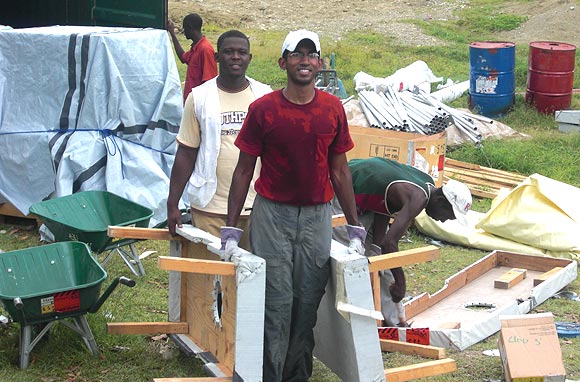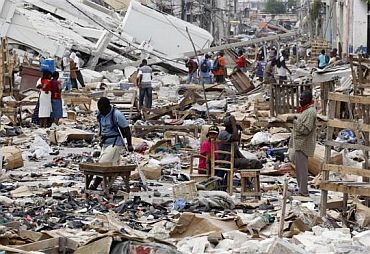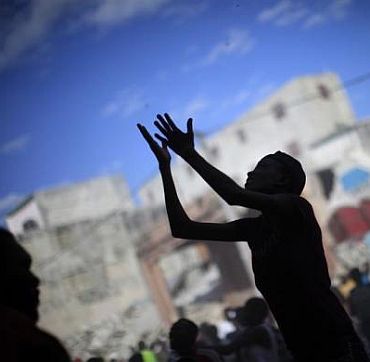 | « Back to article | Print this article |
The fascinating journey of the Indian Rhodes Scholar from Mexico to Haiti
Arthur J Pais discovers what drives this year's Rhodes Scholars in a four-part series.
Anand Habib, one of the Rhodes scholar this year, volunteered for a halfway house for immigrants who had risked their lives to come to America through the Mexican border during his high school days. He shares his journey here.When he was about 13 years old, Anand Habib asked his biochemist parents Geetha and Mohamed Habib if he could spend a few days in an Indian village.
He wanted to see for himself how people managed to survive despite hardships and also see how non-governmental organisations and the government sought to alleviate some of the problems. So his father took him to his village deep down in Tamil Nadu's south.
"He told me he did not want to stay in a place just for a few days," his father recalled last week, soon after Anand had been declared one of the 32 winners in the United States in the fiercely fought for Rhodes Scholarship.
"He wanted to go abroad, not only to India but other parts of the world and work in relief camps and other humanitarian projects," Mohamed Habib added.
For the last few years, Anand, who grew up near Houston and volunteered in his high school years for a halfway house for immigrants who had risked their lives to come to America through the Mexican border, has been doing that. He has worked in India, Mexico, Guatemala and Haiti, with medical and professional NGOs.
Anand, who graduated with a biology degree from Stanford, has spent the past four months in Haiti, where he has learned Creole and treats cholera and other conditions that have become dangerously prevalent following the 2010 earthquake. He is serving as a public health fellow and interim administrative director at a clinic run by the Medical Missionaries.
Habib flew back to Haiti soon after the final Rhodes interviews in Houston. He will work there for at least eight more months.

'All is possible for he who believes'
You are in Haiti and you have worked in Guatemala, Mexico and India with NGOs. You have written vividly in your journal.
I remember looking up to see an emaciated representation of Christ nailed to a cross and above him are written the words, 'todo es posible para el que cree' -- all is possible for he who believes.
In the year since I visited the traditional medicine centre high in the mountains of Oaxaca (Mexico) in whose chapel these words were carved, I have often pondered the meaning of that saying.
In Guatemala, I found myself again revisiting and questioning the power of faith. Everyday, my comrades and I eat breakfast and dinner at the Catholic parish among the company of tens of volunteers from the US on mission trips.
For me, religion and spirituality is an intensely personal topic, yet for these groups, their faith has compelled them to travel thousands of miles to this small hamlet on the shores of Lake Atitlan.
Over lunch today, I overheard Adam Gorlick, a reporter from the Stanford News Wire Service documenting our trip, chatting with the leader of one of these groups about liberation theology, a concept gaining steam in Latin America that has redefined the Church's mission with a focus on freeing the poor from the bonds of cyclical poverty... This concept is one that Paul Farmer, co-founder of Partners in Health and an inspiring role model, has often talked about as a motivation behind his own work in fighting to diminish the inequitable burden that the poor face with respect to infectious disease.
Later in the day, I and some people in my team found ourselves rapt in deep conversation with Panchita who was providing us insight into traditional Mayan beliefs about prenatal care. Without cue, she ventured to create for us a picture of how the people used the land and nature to do what western medicine sometimes struggles to do -- ensure the birth of healthy babies at low risk to the mother.
Among the things she mentioned were the varied uses of Quetzalteca, a liquor that smells strikingly similar to vodka or tequila, to speed up labour or to reduce labour pains, a practice not surprisingly frowned upon by doctors.
More interesting was the use of drops of urine applied directly to the ear to treat ear infections and a dubious mix of urine and pineapple juice to treat diabetes. She recounted these sundry elixirs all the while asserting that they truly did work -- that is if you believed they would.
After an enthralling two-hour conversation, we met with her brother Angel who told us how faith is something which we must all personally find; no one can persuade you to be spiritual, but for those with faith, for those who believe in the abilities of San Simon, the patron saint of the local church, prayers will be answered.
As we strolled back towards the parish for dinner, I found my own prayers had been answered. The relentless rain that had caused us to scrap our plans to return to San Juan Mirador had finally subsided. As in that town in Oaxaca, I find that faith and medicine go inextricably hand in hand wherever I go. Maybe it is true -- todo es posible si cree.
'I've realised that good intentions mean little if not accompanied by good outcomes'
I'm not sure how my love for social justice began... I am continually motivated by two things. The first is an appreciation of the opportunities that have been given to me and the understanding that there are countless others in the world who will never have such opportunities. My parents have sacrificed so much for my sister and me and I've been fortunate to have many friends and teachers support me through the years. As my mom tells me from time to time, 'Much is given, much is expected.'
The second, perhaps more enduring motivation, is the stories of people I meet in places like India, Oaxaca, Guatemala, and Haiti but also in the Central Valley of California and even in Palo Alto, around Stanford University in some of the poorest areas in California.
I am eternally grateful for those who have shared their stories with me because in part they form the fire that keeps me going.
What have you learned from your experiences in Haiti and Mexico?
I think the experiences have taught me both common and distinct lessons. One of the common lessons I've learned is the extent to which US policies can impact outcomes in Mexico and Haiti.
For instance, the North American Free Trade Agreement has led to the demise of many small farms in southern Mexico leading many individuals to migrate to the US in search of employment opportunities.
In Haiti, US foreign policy -- whether in the form of loan packages or neo-liberal economic policies -- have fundamentally shaped Haitian domestic politics in some fairly dramatic ways, both good and bad. I think my time in Haiti, though, has been particularly eye-opening.
I've realised that good intentions -- especially with respect to NGOs -- mean very little if they are not accompanied by good outcomes. Haiti has become such an unfortunate patchwork of NGOs who have seemingly done little to coordinate their activities amongst themselves or with the government.
Ultimately, it's the people who suffer when such unsustainable initiatives are undertaken.
What was your best experience working in India?
I spent four weeks teaching health education -- the importance of drinking boiled/filtered water, hygiene, and nutrition -- to sixth to ninth graders at AGN Matric School in Konganapuram, Tamil Nadu, through a student-run group at Stanford called Project Dosti. I think my best memory from this experience was on the last day.
The school principal had a few students stand up at morning assembly to tell their classmates what they had learned from our group of six Stanford students. About half of the kids mentioned something about the difference between bacteria and viruses, something I had taught them.
As a teacher, it's always difficult to know if students are learning, so it was nice to see that something I had said stuck with them.
I've realised that I can no longer overlook the socioeconomic and political dimensions of health'
The wails from the adjacent cholera ward pierce the Haitian night. I jolt awake, filled with indignation.
"What a 'stupid' death," Haitians would say. In the twenty-first century, no one should die of cholera, not even here in the Western Hemisphere's poorest country, where injustice is aplenty, but hope, as with potable water, remains a luxury. Although progress towards greater health equity is slow, I still believe as Martin Luther King, Jr did, "the arc of the moral universe is long, but it bends toward justice."
Through an appreciation of the bio-social nature of health and an embrace of pragmatic solidarity via service, advocacy, and research work, I have resolved to help pen a more hopeful future.
My commitment to social justice sprung from volunteer work during high school at Casa Juan Diego, an immigrant half-way house in Houston. There, I met individuals seeking refuge after a harrowing cross-border journey. They arrived fatigued and dishevelled, suffering from unknown illnesses. Vigilante Minutemen camped outside, however, often prevented them from seeking needed medical care.
At Stanford, I began to confront such health injustices by teaching ten-week courses on nutrition, exercise, and substance abuse to disadvantaged youth in East Palo Alto.
Appreciating the value of my own education, I viewed my actions as a method of empowering underserved youth to choose healthful behaviours. My students' enthusiasm encouraged me to use health education as a tool to tackle pernicious health inequities in India.
For four weeks in 2008, I taught 120 students a curriculum designed to address local health needs, including the importance of good hygiene and a balanced diet. A conversation, however, with two students, Dotam and Arun, led me to question the efficacy of my actions.
They astutely identified the environmental degradation and staggering poverty plaguing India yet concluded that deep-seated corruption would undermine their attempts to address these ills. Health education alone could not overcome the underlying realities that threatened their health and limited their agency.
I have realised repeatedly that I can no longer overlook the socioeconomic and political dimensions of health. While shadowing in the overflowing wards of Hospital Civil on a service-learning trip in Oaxaca, I listened as a patient's father heard that doctors could not determine how his daughter had contracted fulminant hepatitis. The list of possibilities was too long, and the time left to act too short.
Mayan women whom I surveyed about pre-natal care in Guatemala lamented their loss of children from peri-natal complications; yet, they expressed wariness at visiting clinics operated by a government which had waged a bloody civil war against them and staffed by Mestizo physicians who treated them disdainfully.
Even in East Palo Alto, lack of grocery stores and chronic violence hindered the students whom I had taught from eating healthfully and exercising.
By engaging in health work globally, I have also become startlingly aware of the historical underpinnings of health inequity.
Excerpted from Anand Habib's Rhodes Scholarship essay



